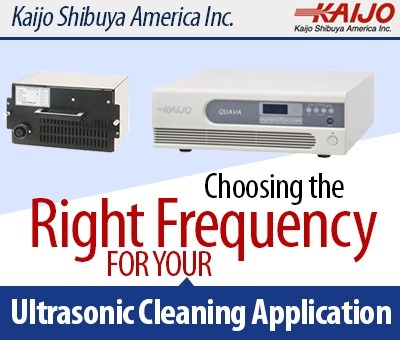Choosing the Right Frequency for Your Ultrasonic Cleaning Application
March 21, 2016

The cleaning action of industrial ultrasonic cleaning systems depends on the high-energy collapse of tiny cavitation bubbles formed by the sound waves in the cleaning liquid. When the bubbles collapse, they release a momentary burst of energy that removes impurities and contaminants from the surfaces of the parts to be cleaned. The higher the frequency, the less time bubbles have to grow between sound wave cycles of compression and the smaller the bubbles. Small bubbles are less energetic but, for a given power input, there will be more of them. As a result, high frequency ultrasonic cleaning with lots of tiny bubbles delivers finely distributed gentle cleaning while lower frequencies with fewer and larger bubbles give a more energetic coarser-grained cleaning action. Choosing the equipment that provides the right ultrasonic cleaning frequency for your application is key to obtaining effective cleaning.
Lower Frequencies for Cleaning Metal and Glass Parts
The low frequency end of Kaijo’s industrial ultrasonic cleaning systems ranges from 26 kHz to 38 kHz. Cleaning systems such as the Phenix III Turn Key system operate at these frequencies. They can remove tough surface contaminants but their high cleaning energies are not suitable for soft materials or delicate parts. Typical items that can be cleaned with these systems are hard metal machined parts, glass, jewelry, wires and medical equipment.
Mid-Range Frequencies for Precise Cleaning
The Kaijo Phenix Legend operates at mid-range frequencies from 78 kHz to 160 kHz and can clean less robust parts and materials successfully. The cleaning of hard disk drives, LCDs, solar cells and panels, aluminum parts, quartz transducers and ceramic parts are typical applications. As an accessory for the Phenix Legend products, Kaijo offers a water resonance system (WRS) that conditions the cleaning water to optimize bubble formation and improve cleaning performance.
Gentle Cleaning at High Frequencies
At 450 kHz to 950 kHz, cleaning is precise without the risk of damage to delicate components. The Quava series of industrial ultrasonic cleaners can clean parts made of soft materials and with intricate surfaces that require careful handling. Typical parts cleaned at these frequencies include semiconductor wafers, electronic components, delicate medical instruments and LEDs.
The Quava Spot ultrasonic generator works with the Spot Shower and Mega-Tube Nozzles for directed cleaning of hard disk drive surfaces, flat panel display glass and semiconductor wafers.
Flexible Cleaning Options
For industries that have multiple cleaning applications, it remains important to perform cleaning tasks using industrial ultrasonic cleaners that operate at the appropriate frequency. Rather than requiring customers to purchase several products for different frequencies, Kaijo offers cleaning systems that can operate at the various frequencies that are needed.
As well as covering the mid-range frequencies, the Phenix Legend can also operate at 38 kHz to deliver the robust cleaning action of the lower frequency bands. The Quava Multi can cover either the 26 kHz to 130 kHz or the 38 kHz to 160 kHz ranges. The new generation all-purpose Quava can operate at ten different frequencies, ranging from 26 kHz to 950 kHz. With such broad flexibility, these cleaners can handle many kinds of cleaning applications in one unit. The broad spectrum of industrial ultrasonic cleaners offered by Kaijo ensures that it is possible to get the most effective cleaning solution at the right frequency no matter what the cleaning requirements.
If you have any questions about selecting equipment that provides the right ultrasonic cleaner frequency for your application Contact Kaijo for a free quote or consultation.





